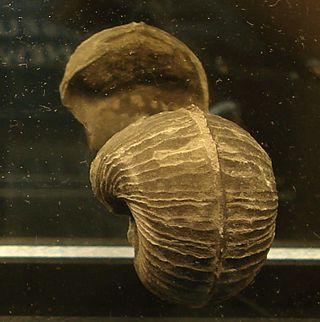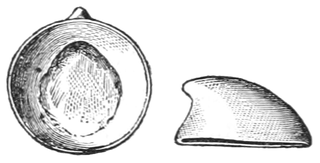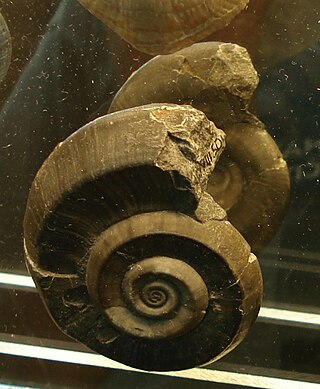
Bellerophon is a genus of extinct paleozoic marine molluscs of uncertain position in the family Bellerophontidae.

The Bellerophontida is a taxonomic order of extinct marine mollusks that are found in the fossil record from the Lower Cambrian to the Lower Triassic. They are considered by some experts to be primitive sea snails with primarily symmetrically coiled shells, marine gastropod mollusks.

Helcionelloida is an extinct group of ancient molluscs. These are the oldest known conchiferan molluscs, that is, they had a mineralised shell. Some members of this class were mistaken for Monoplacophorans. The class was erected by Peel in 1991.

Eucyclidae is a family of gastropods in the superfamily Seguenzioidea.

Bellerophontoidea, common name "bellerophonts", is a superfamily of extinct planospirally-coiled globose molluscs. This superfamily is generally included within the Gastropoda, but may instead be a group of monoplacophorans. The taxon first appeared late in the Cambrian and continued until late in the Triassic.

Coreospiridae is an extinct family of Paleozoic molluscs of uncertain position taxonomically. They might be snails (Gastropoda), Helcionelloida, or they might be Monoplacophora.
Metoptomatidae is an extinct family of fossil mollusks from the Paleozoic era. These mollusks are either.
Patelliconidae is an extinct family of Paleozoic fossil molluscs. It is not known whether these were Gastropoda or Monoplacophora.
Protoconchoididae is an extinct family of Paleozoic molluscs of uncertain taxonomic position, i.e. they were either.

†Archinacellidae is an extinct family of paleozoic molluscs of uncertain position.
†Archaeopragidae is an extinct family of paleozoic molluscs of uncertain position.
Bucanellidae is an extinct family of Paleozoic molluscs of uncertain position, belonging either to Gastropoda (snails) or Monoplacophora. The family lived from the upper Cambrian to middle Permian and the shells are characterized by a relatively small median sinus in the upper margin of the aperture, and collabral (transverse) or spiral (longitudinal) threads covering the shell. The shells are planispirally coiled rather than trochospirally with a spire as is the case with most shelled gastropods.
Tropidodiscidae is an extinct family of Paleozoic fossil molluscs with isostrophically coiled shells. They are of uncertain position taxonomically, in other words it is not known whether they were s.
Bucaniidae is an extinct family of Paleozoic molluscs of uncertain position possibly being either gastropods or monoplacophorans in the superfamily Bellerophontoidea. The family lived from the Lower Ordovician to the Devonian and have shells in which the apertural margins tend to flare. Most genera have a slit and selenizone, others some modification of this feature.
Euphemitidae is an extinct family of Paleozoic fossil molluscs of uncertain position. They have isostrophically coiled shells and may be either Gastropoda sea (snail)s, or Monoplacophora.
Pterothecidae is an extinct family of Paleozoic molluscs of uncertain position, either Gastropoda or Monoplacophora, with isostrophically coiled shells.
Sinuitidae is an extinct family of Paleozoic molluscs of uncertain position. They had isostrophically coiled shells.

Macluritidae is an extinct family of relatively large, Lower Ordovician to Devonian, macluritacean gastropods(?), hypserstrophically coiled, that is dextral while appearing sinistral, of which the genus Maclurites is arch-typical. The base of their shells is flat or gently protruding while the upper side is generally concave.

Euomphaloidea, originally Euomphalacea, is an extinct superfamily of marine molluscs that lived from the Early Ordovician to the Late Cretaceous, included in the Gastropoda but speculated as instead perhaps Monoplacophora.
The taxonomy of the Gastropoda as it was revised in December 2017 by Philippe Bouchet and eight other authors, is a publication which lays out a newly revised system for the scientific classification of gastropod mollusks. The same work also included the taxonomy of monoplacophorans.






